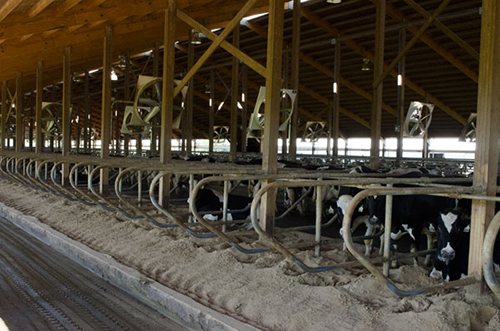
Selecting the ideal bedding for a farm can be a difficult and intensive project. Producers must consider milk quality and production goals, facility abilities and economics. No magic bedding has been identified that excels in all situations. That being said, inorganic bedding, such as sand, has been touted as a good option for achieving high production and low bulk tank somatic cell counts. On the flip side, it is notoriously hard on equipment. However, recent research in Wisconsin shows that more and more herds, especially large ones, are choosing inorganic options.
Of dairies in that state producing more than 25,000 pounds of milk per day, 60 percent of farms bedded with inorganic material, while 19 percent bedded with organic bedding and 9 percent with manure products. The remaining farms studied used a combination of methods depending on the pen. Over the course of two years, the study recorded milk production and bulk milk somatic cell score for each farm as well as management practices and bedding choices.
Researchers found that operations bedding with inorganic materials had the lowest average somatic cell count and highest average milk production. They topped the rolling herd averages of herds bedding with organic materials and manure products by 1,696 pounds and 2,537 pounds, respectively. They also noted that herds using manure products had a higher proportion of cows whose milk was dumped and that were three-quartered, indicating a likelihood of more chronic mastitis cases.
Within the herds that bedded with sand, stall management including grooming and the addition of new bedding remained an important factor in controlling somatic cell count. Farms that bedded more than twice a week averaged a higher bulk milk somatic cell count. Researchers associated this with the inorganic bedding's tendency to have maximum pathogen exposure one to two days after it is placed in the stalls.
Overall, the data showed the industry's emphasis on production of high quality milk for the domestic and international market has paid off. All herds included in the study recorded bulk milk somatic cell counts below 400,000 cells/mL throughout the research period. As the market continues to encourage low somatic cell counts and high production, producers will continue to make management and bedding decisions that reflect their best opportunities for success.

The author is the Special Publications editor. She is responsible for development and marketing of books and plans, as well as coordinating internal communication pieces. Maggie was raised on a 150-cow dairy near Valley Center, Kan. and graduated from Kansas State University with degrees in agricultural communications and animal sciences.





